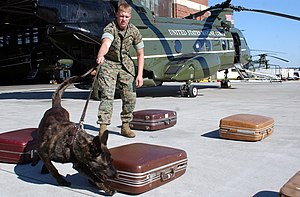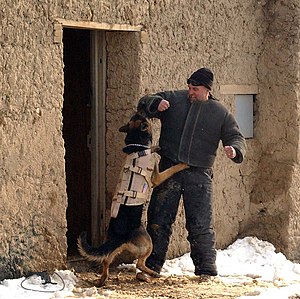The hero in the romantic suspense novel I’m currently working on isn’t perfect. He’s cynical, dangerous…and suffers from PTSD—Post Traumatic Stress Disorder. It’s a sad testament to our times that we all immediately recognize the name. However, not everyone is aware that military service dogs can develop PTSD too. These animals may exhibit the same symptoms as humans, i.e. fearfulness, anger, distrust, withdrawal.

- English: A Military Working Dog practices searching bags in front of a HMX-1 utility CH-46. (Photo credit: Wikipedia)
Military dogs are trained to perform duties deemed too dangerous for people. They sniff out explosives, detect snipers and go first into areas where the enemy might be waiting in ambush. The work they do is dangerous and grueling, performed only because of the loyalty and bond shared with their handlers. They save lives and sometimes make the ultimate sacrifice just like their human counterparts. These dogs are heroes in every sense of the word.
What happens to them after they’ve served their country? What if they’re wounded and no longer able to perform their duties?

It’s no surprise that VA benefits don’t apply to these retired military warriors. Up until 2000, they were simply euthanized. This included not only mentally and physically disabled dogs returning from war, but dogs that had grown too old to perform their duties and even young dogs that flunked out of the training program. In other words, any animal that ceased to be an asset to the U.S. Military suffered the same fate.
Robby’s Law, named in honor of a military dog, changed everything for future generations. Despite repeated efforts by Robby’s handler to adopt him, Robby was euthanized, giving momentum to this law, adopted and signed by President Clinton in November, 2000. Though the law didn’t save Robby, it has saved the lives of countless other disabled and retired military service dogs.
Now, dogs in the program that don’t pass their aptitude tests, as well as dogs who have served their country, are offered for adoption and the personal handler is given priority. Last year, over 400 dogs were adopted into new homes.
Thinking of adopting a war hero? You can put your name on the list at Lackland Air Force Base, the training center for these dogs, but it could be up to two years before one of them becomes available and the adoption criteria is stringent.

Not all of us are cut out to adopt military heroes, but there are many older dogs and dogs with health issues just waiting at a shelter or a rescue organization near you. They may have never sniffed out a bomb but they could manage an excited shake of a tail if they had a warm place to sleep, a human to love them and good food. Stop by for a visit sometime. You might even decide to be a hero to one of them.
A few years ago, a little dog named Sophie came into my life. A stray, the humane society didn’t know her age, but diminished eyesight and lack of hearing and coordination told me she was considerably older than the six years they suggested. She was my shadow for a little over four years, and I’m proud to say her last years were happy ones. I got the better end of the deal though. I got to feel like a hero.
Heroes come in many shapes and sizes. What’s your idea of a hero?




